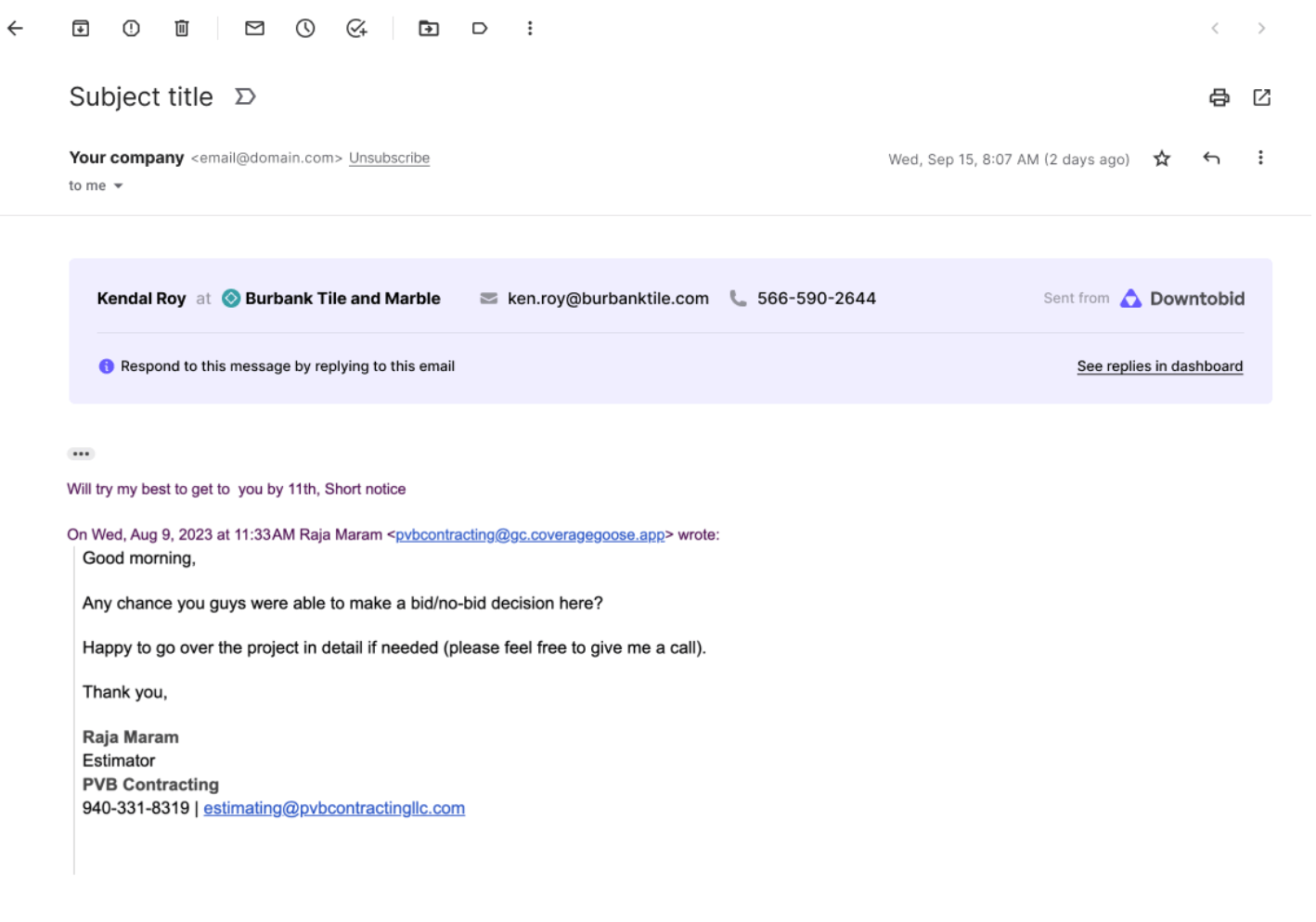How To Ask A Contractor For A Bid: A Comprehensive Guide
Written by Bridget Cooper

After mulling over a construction project for years and setting aside finances, it’s time to put it up for bidding to solicit the best possible price. Finding the right general contractor sets you on a path to successful project completion. However, how do you convince a contractor to bid on your project? How do you know you’re targeting the right contractors?
This guide explains how to write a request for a bid that captures the contractors’ attention. We will also look at how you can automate the entire process, saving you time and resources.
Note: Try Downtobid to manage all of your bids in one place. Our tool will use AI to dissect project plans, send personalized bid invites, and streamline your bidding process. Cut your bid preparation time by up to 30%. Get started today.
How Do You Write a Request For a Bid?
A request for bid (RFB), or an invitation to bid (ITB) for construction, is a document prepared by the project owner to solicit bids from qualified contractors.
An RFB outlines detailed project specifications, including project scope, materials, measurements, plans, contract terms, and timeline. It also outlines the bidding process, ensuring every bid follows a specific format.
Here are the steps to write an RFB
Define your Project and Needs
Every construction project is unique, with varying designs, scope, materials, and labor requirements. Start with a brief overview of the company, like name and addresses, and why this project is important.
You must outline project goals, like what the project aims to achieve. Project goals need to be specific and realistic with measurable outcomes. For instance, an elementary school construction project could have a goal like constructing accessible classrooms for students with disabilities.
The scope of work is the beating heart of any RFB. It includes all the details like construction materials, timeline, tasks and activities, labor, and equipment requirements. It''s usually used for cost breakdown to explain the entire project price. A detailed scope helps contractors understand the project better and come up with accurate estimates.
Finally, you must include a project budget range that contractors must match in their bids. Be transparent and leave contractors enough room to negotiate their rates.
Provide Detailed Project Specifications
A great RFB must define and explain project specifications to help contractors be on the same page with their clients regarding the project. This section of an RFB mostly focuses on three crucial details - technical requirements, deliverable format, and evaluation criteria.
Under technical requirements, you must mention the performance standard, like work speed, project accuracy, workplace safety and security, and uptime. You must also include construction equipment and their compatibility requirements. If the construction project requires software, you must mention it, including version, licensing, and compatibility.
The deliverable format helps contractors understand the bid formats acceptable to the client. You must cover the formatting guidelines and the acceptable file formats, e.g., Docx, PDF, etc. If you require regular reporting, you must also mention it here, including the content in the report, frequency, and format.
The evaluation criteria section outlines the methods you’ll use to select the most accurate bid. An RFB mostly focuses on the lower price when selecting a preferred bidder, so it’s a given that this will be at the top of the list.
How much influence will experience have in the final selection? Make sure you mention that. Ensure you state the qualification requirements for this project. For instance, you could mention licenses and certifications, insurance, and financial stability as basic qualifications for a desirable contractor.
Setting Submission Guidelines
Every bid submission is different, depending on the client’s needs. This section helps bidding contractors understand the acceptable bid submission process to ensure a streamlined submission and evaluation process.
Specify the submission method, whether it’s electronic or mailed. If there is a specific bid submission platform that contractors must use, mention that here.
Every bidding process has a timeline, and you should include the deadline here. It’s crucial to allow contractors ample time to prepare and submit bids.
Include a list of required documents that contractors must include in their bid submission. Required documents include financial documents proving their financial health, resumes, and technical specifications.
Transparency and open communications are key to any successful bidding. Encourage all bidders to ask questions to clarify any details. Doing so ensures everyone has a common understanding of the project.
Finally, you must address the selection process and the timeline to announce the successful bid. Such clarity helps foster trust with bidders and manage expectations.
Further Considerations
Besides the basic RFB details, some construction projects have specific requirements for the project’s sensitivity. For instance, certain government contracts are sensitive, with some details not allowed to be shared with the public. In such cases, contractors might be required to sign nondisclosure agreements to protect the sensitive data.
Contract terms help to ensure every party understands their roles and responsibilities. The contractor is tasked with delivering the product per requirements, and the client must provide financing to complete the project.
Have Downtobid Do It All for You.
Writing an RFB is tedious, requiring crafting different documents and ensuring the details align with the project’s objectives. Developing a single RFP also takes a lot of time and money. Luckily, Downtobid can do this for you in under an hour, and all you need is your designs and plans. We will see how it works later, but first, let’s look at Downtobid.
What is Downtobid?
Downtobid is a construction bid management software used by contractors and subcontractors. The platform comes in handy during the pre-construction and estimation stages. It utilizes the AI Copilot feature to review bid packages for completeness and accuracy. The IA Copilot also helps contractors identify appropriate bid packages and the right subcontractors.
Downtobid Key Features
Downtobid boasts of outstanding features to streamline the entire bidding process. They include:
AI Copilot for Automation
As we match into the AI era, Downtobid is ahead of the curve by successfully incorporating AI into its platform. The AI Copilot acts like a real-life copilot, helping take care of basic administrative tasks and allowing you to focus on more complex tasks.
First, the AI checks all the bidding documents for accuracy and completeness almost instantly. Without AI, page turns would take a lot of time and hourly wages for hiring professional organizations specializing in these services to go through the documents.

The AI creates a detailed scope of work to ensure contractors have the necessary information and eliminates any scope gaps.
Creating Bid Invites Almost Immediately
Downtobid helps create a detailed construction bid invite in minutes by uploading the project plans.
The system analyzes these plans and creates a detailed bid package, saving you time and money.
Every bid invite is customized, including contractors’ details like names and addresses. Doing so makes the bid personalized, helping create a genuine connection with every contractor.

Now that we know what Downtobid is and its features, let’s see how this platform can help you create an RFB.
Here’s How It Works
First, go here to start creating your project.
You will see the project page where you can upload the documents.
Upload the project plans, enter your email, and the AI will handle the rest.
Once uploaded, the AI takes around 30 minutes to analyze the project plans, determine the scope, and craft the appropriate bid package. You will receive an email about your new construction bid package, which you can access after logging in.
The bid package contains pages with simple scope sheets highlighting the bid package’s description, any scope in the plans, and recommended subs qualified for the project.
The AI recommends the best bidding schedule to target contractors at the right time. Every bid package contains the project summary and scope that contractors can examine to understand the project without going through the project plans. The system schedules automatic follow-ups, freeing you from administrative duties to focus on complex responsibilities like reviewing the bids.
The centralized message board allows you to respond to emails from the platform, allowing for speedy communication.
How do you Tell A Contractor you are Getting Other Bids?
Although you’re not obligated to tell contractors you’re getting other bids, it helps to promote transparency and build trust. Before we look at how you can break this news to contractors, let’s see the benefit of doing so.
Informing contractors about other bids acts as a negotiating leverage, forcing contractors to propose the best bids in an attempt to outbid competition. The bidding war is good for project owners since it leads to lower and more desirable bids. Contractors also recommend different materials and construction methodologies aiming to reduce costs, giving project owners more options.
Here is how you do it.
First, never disclose personal information regarding other bidders, like names or prices. Secondly, timing is crucial, and you should inform contractors before they send their final quotes. Doing so gives them enough time to adjust their offer should they wish to compete for the project.
The delivery method should be modest and professional, like an email or a phone call. Avoid being harsh or pointing out their weaknesses. Instead, be polite and keep the message short. For instance, you should thank them for the submission and mention that you’re currently reviewing bids from multiple contractors to help you make an informed decision.
Try negotiating if you find a suitable contractor whose initial contract is beyond the budget. After thanking them for the bid, you should point to what has impressed you more about their proposal and ask if they’d be interested in negotiations.
Here are a few templates to help you understand better:
_“Dear XX, thank you for taking the time to review our ITB and submit your bid. We appreciate the effort and interest in this project, and we will do our best to get back to you as soon as possible. Kindly know that we’re reviewing multiple bids from several contractors to help us choose the best contractor for the job.” _ Here’s another one attempting to negotiate with the contractor:
“DearXX, thank you for bidding on our project. We are impressed by your construction methodology and proposed alternative materials. We have looked into these details and believe your approach could work. However, we find your bid slightly higher than our budget and wondered whether you’d be open to negotiations. Kindly let us know your thoughts.”
Final Thoughts
Finding the right contractor is crucial to the success of every construction project. A detailed RFB helps target the right contractor by providing a detailed scope of work, but creating the bid package takes time and money. However, Downtobid simplifies this process by crafting detailed RFBs within minutes. The AI Copilot handles administrative tasks like checking the documents for completeness. Telling your contractors you are receiving other bids gives you negotiating power, providing you with more options for qualified bids.